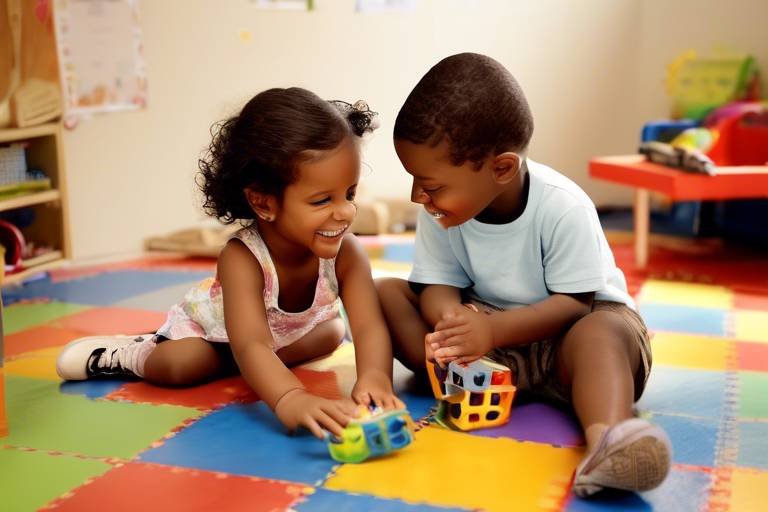Helping Your Child Make Healthy Media Choices
In today's digital age, where screens are an integral part of our daily lives, guiding your child to make healthy media choices is more important than ever. With countless apps, videos, and games vying for their attention, how can we ensure they engage with content that is not only entertaining but also enriching? As parents, we play a crucial role in shaping their media habits, and it all starts with understanding the landscape of media literacy.
Media literacy goes beyond just knowing how to use a device; it involves the ability to critically evaluate the information presented. Children need to develop the skills to discern between reliable sources and misleading content. This means teaching them to ask questions like, "Who created this content?" or "What is the purpose behind this message?" By fostering a mindset of inquiry, we empower our children to navigate the digital world with confidence and caution.
As we embark on this journey, it's essential to set clear screen time limits. Just like a balanced diet, our media consumption should be moderated. Establishing boundaries around screen time not only protects our children's well-being but also encourages them to explore other interests. So, how do we go about setting these limits effectively? One approach is to create a family media plan that aligns with our values and priorities.
Media literacy is crucial for children to critically evaluate content. This section discusses the skills needed to discern reliable information from misleading sources.
Establishing appropriate screen time limits is essential for children's well-being. Here, we explore effective methods for parents to set and enforce these boundaries.
A family media plan helps structure media consumption. This subheading outlines steps to create a tailored plan that reflects family values and priorities.
Engaging children in media planning fosters responsibility. This section discusses techniques for involving kids in decision-making about their media use.
Regularly reviewing the family media plan ensures it remains effective. This part emphasizes the importance of flexibility and adaptation to changing needs.
Promoting uplifting and educational content is vital. This subheading highlights strategies for parents to encourage children to seek out enriching media experiences.
Children often emulate their parents. This section discusses the significance of adults modeling positive media behaviors to influence children's choices.
Encouraging a balance between online and offline activities is crucial for holistic development. This subheading outlines ways to integrate physical and social activities into daily routines.
- How much screen time is appropriate for children? The American Academy of Pediatrics recommends that children aged 2 to 5 should have no more than one hour of high-quality programming each day. For older children, it's essential to balance screen time with other activities.
- What are some educational media options for kids? Look for apps and programs that promote learning through play, such as coding games, interactive storybooks, and educational documentaries.
- How can I encourage my child to choose positive content? Discuss with your child the types of shows or games that are educational or promote positive messages. You can also co-view content to help them understand what to look for.

Understanding Media Literacy
This article explores strategies for parents to guide their children in making informed and balanced media choices, fostering a healthy relationship with technology and digital content.
In today's digital age, understanding media literacy is more important than ever for children. Media literacy equips kids with the skills they need to critically evaluate the content they encounter online. This means they can distinguish between reliable information and misleading or false sources. Imagine media literacy as a pair of glasses that helps children see clearly through the fog of misinformation that often clouds the internet. Without these glasses, they might easily fall prey to sensational headlines or biased articles.
To effectively navigate the vast ocean of digital content, children need to develop several key skills:
- Critical Thinking: This involves analyzing and questioning the information presented to them. Are the claims backed by evidence? Who created this content, and what is their intent?
- Source Evaluation: Children should learn to identify credible sources. This means recognizing reputable websites, authors, and organizations that provide accurate information.
- Understanding Bias: It's essential for kids to understand that not all content is neutral. They should be taught to recognize bias in media and how it can influence the information they consume.
- Digital Footprint Awareness: Kids must grasp the concept of their online presence and how their actions can have lasting implications. This includes understanding privacy settings and the importance of protecting personal information.
By fostering these skills, parents can help their children navigate the digital landscape with confidence. For instance, when discussing a news article or a social media post, parents can encourage their kids to ask questions like: "What evidence supports this claim?" or "How might this information affect my perception of the topic?" This kind of dialogue not only builds critical thinking skills but also strengthens the parent-child relationship.
Moreover, media literacy isn't just about avoiding pitfalls; it's also about empowering children to seek out positive and enriching content. When children understand how to identify quality media, they are more likely to engage with educational resources that can enhance their learning and personal growth. Think of it as giving them a treasure map to find the gems hidden among the rocks of the internet.
In summary, media literacy is a vital tool in helping children navigate the complexities of digital content. By equipping them with the necessary skills to critically assess information, parents can foster a generation of informed and responsible media consumers. It's not just about protecting them from harmful content; it's about empowering them to make smart choices that contribute positively to their development.
Establishing appropriate screen time limits is essential for children's well-being. Here, we explore effective methods for parents to set and enforce these boundaries.
A family media plan helps structure media consumption. This subheading outlines steps to create a tailored plan that reflects family values and priorities.
Engaging children in media planning fosters responsibility. This section discusses techniques for involving kids in decision-making about their media use.
Regularly reviewing the family media plan ensures it remains effective. This part emphasizes the importance of flexibility and adaptation to changing needs.
Promoting uplifting and educational content is vital. This subheading highlights strategies for parents to encourage children to seek out enriching media experiences.
Children often emulate their parents. This section discusses the significance of adults modeling positive media behaviors to influence children's choices.
Encouraging a balance between online and offline activities is crucial for holistic development. This subheading outlines ways to integrate physical and social activities into daily routines.
Q: What is media literacy?
A: Media literacy is the ability to access, analyze, evaluate, and create media in various forms. It helps individuals discern reliable information from misleading content.
Q: How can I help my child develop media literacy skills?
A: Engage your child in discussions about media content, encourage critical thinking, and teach them to evaluate sources for credibility.
Q: What are some signs of excessive screen time?
A: Signs include irritability when not using devices, difficulty concentrating, and neglecting offline activities and relationships.
Q: How can I set appropriate screen time limits?
A: Establish clear rules based on your family's values, involve your children in the decision-making process, and regularly review and adjust the limits as needed.

Setting Screen Time Limits
Establishing appropriate screen time limits is essential for children's well-being in today's digital age. With the vast array of engaging content available at their fingertips, it can be all too easy for kids to lose track of time. As a parent, you might find yourself asking, "How much screen time is too much?" The truth is, the answer can vary depending on your child's age, personality, and individual needs. However, setting clear and consistent boundaries can help your child develop a healthier relationship with technology.
One effective method to set screen time limits is to establish a daily schedule. This schedule should reflect your family's values and priorities while considering your child's activities, such as homework, outdoor play, and family time. For instance, you might allocate specific hours for screen use, such as one hour of educational content after school, followed by a family movie night on weekends. By doing so, you create a balanced routine that emphasizes both digital engagement and real-world experiences.
To make this process smoother, consider involving your child in the conversation about screen time limits. Ask them how much time they think they should spend on screens and what activities they enjoy. This approach not only empowers them but also helps them understand the reasoning behind the limits you set. You might say, "If we agree on two hours of screen time a day, how would you like to divide that time between games and educational videos?" This collaborative approach can lead to a more successful outcome.
Another strategy is to utilize tools and apps designed to monitor and manage screen time. Many devices come equipped with parental controls that allow you to set daily limits or restrict access to certain apps during specific hours. This can be particularly helpful when it comes to managing distractions during homework time or ensuring that screens are turned off during family meals. It’s like having a digital safety net that helps guide your child toward responsible media consumption.
It's also crucial to regularly review and adjust these screen time limits as your child grows and their needs change. What works for a five-year-old might not be suitable for a teenager. Make it a family habit to sit down every few months and discuss how the current screen time limits are working. Are they too restrictive? Not restrictive enough? This ongoing dialogue can help you fine-tune your approach and ensure that it aligns with your family's evolving dynamics.
In summary, setting screen time limits is not just about restricting access; it's about creating a balanced lifestyle that promotes healthy media consumption. By establishing a structured schedule, involving your child in the decision-making process, utilizing available tools, and regularly reviewing your approach, you can help your child navigate the digital world with confidence and responsibility.
- What is the recommended screen time for children? The American Academy of Pediatrics suggests that children aged 2 to 5 should have no more than one hour of high-quality programming each day, while children aged 6 and older should have consistent limits on the amount of time spent on screens.
- How can I monitor my child's screen time effectively? Utilize parental control apps or built-in device settings to track and limit screen time. Regular discussions about their media use can also help maintain awareness.
- What should I do if my child resists screen time limits? Engage in open conversations about why these limits are important. Involving them in setting the rules can foster understanding and cooperation.

Creating a Family Media Plan
In today’s digital age, creating a Family Media Plan is not just a good idea; it’s essential. Think of it as a roadmap that guides your family through the vast landscape of media options available today. Just as you wouldn't embark on a road trip without a map, navigating media consumption without a plan can lead to confusion and unhealthy habits. So, how can you create a plan that suits your family's unique needs and values? Let’s dive into the essential components.
First off, it's important to gather your family together for a discussion. This isn’t just about setting rules; it’s about creating a collaborative environment where everyone feels heard. Ask your kids what types of media they enjoy and why. This can include everything from video games and social media to educational apps and family movies. By understanding their preferences, you can better tailor the plan to include their interests, making it more likely they’ll stick to it.
Next, consider setting clear goals for media use. Are you looking to limit screen time, encourage educational content, or promote family bonding through shared media experiences? Whatever your objectives may be, write them down and display them prominently. This way, family members can refer back to these goals, keeping everyone accountable. Here’s a simple table to help outline potential goals:
| Goal | Description |
|---|---|
| Limit Screen Time | Establish daily limits on how long each family member can spend on screens. |
| Encourage Educational Content | Prioritize media that enhances learning and critical thinking. |
| Promote Family Interaction | Set aside time for family movie nights or game nights to strengthen bonds. |
Once you’ve established your goals, it’s time to set specific guidelines for media consumption. This could include rules like no screens during dinner or limiting certain types of content. However, flexibility is key! As children grow and their interests evolve, so too should your guidelines. Regularly revisit and revise these rules to ensure they remain relevant and effective.
Additionally, make sure to incorporate media literacy education into your plan. Teach your children how to critically evaluate the content they consume. Discuss what makes a source reliable and how to identify misinformation. By equipping them with these skills, you're not just setting rules; you're empowering them to make informed choices independently.
Finally, remember that a Family Media Plan should be a living document. It’s not set in stone! Make it a point to review the plan regularly, perhaps every few months, and adjust it based on what’s working and what’s not. This not only keeps the plan relevant but also shows your children that their opinions matter, fostering a sense of responsibility and ownership over their media consumption.
In conclusion, creating a Family Media Plan is about more than just limiting screen time; it’s about fostering a healthy relationship with media that aligns with your family’s values. By involving everyone in the process and regularly revisiting the plan, you can help your children navigate the digital world with confidence and critical thinking skills.
- What is the ideal amount of screen time for children? It varies by age, but the American Academy of Pediatrics recommends no more than 1 hour per day for children aged 2 to 5 years, and consistent limits for older children.
- How can I encourage my child to choose educational content? Introduce them to apps, games, and shows that are both fun and educational. Engage them in discussions about what they watch to spark their interest in learning.
- Can I change the media plan as my child grows? Absolutely! It’s important to adapt the plan to fit your child’s developmental stage and interests.

Involving Children in the Process
Involving your children in the process of creating a family media plan is not just a smart move; it's a game changer! When kids actively participate in decision-making about their media use, they not only feel a sense of ownership but also develop critical thinking skills that will serve them well in the digital age. Think about it: when was the last time you felt more committed to something because you had a say in it? That’s the power of inclusion!
Start by having an open and honest conversation with your children about media consumption. Ask them what they enjoy watching or playing and why. This can lead to a deeper understanding of their interests and preferences. You might be surprised to learn that they have thoughts on what’s appropriate or beneficial for them. Encourage them to express their opinions freely, and be sure to listen actively. This not only builds trust but also shows them that their views are valued.
Once you’ve gathered their insights, work together to establish some ground rules. For instance, you might create a list of criteria that content should meet before it’s considered acceptable. Here’s a simple example:
| Criteria | Description |
|---|---|
| Age-Appropriate | The content should be suitable for their age group. |
| Educational Value | Encourages learning or personal growth. |
| Positive Messaging | Promotes kindness, respect, and understanding. |
Engaging your children in setting these criteria not only empowers them but also helps them develop a discerning eye for media. They’ll start to understand that not all content is created equal and that some choices are more enriching than others. You can even turn this into a fun activity by making a colorful poster of the agreed-upon criteria and hanging it in a common area of your home. This visual reminder can serve as a guide for everyone in the family.
Moreover, consider using media as a bonding experience. Watch shows or play games together, and then discuss what you’ve seen or done. Ask questions like, “What did you think about that character’s decision?” or “How did that story make you feel?” These discussions can lead to valuable lessons about empathy, ethics, and the impact of media on our lives. It’s not just about consuming content; it’s about processing and understanding it together.
Lastly, remember that this is an ongoing process. As your children grow and their interests evolve, revisit the media plan regularly. Encourage them to suggest new content or even new criteria as they become more media-savvy. This not only keeps the conversation alive but also nurtures their ability to make informed choices independently. It’s like teaching them to fish rather than just giving them a fish—an invaluable life skill!

Reviewing and Adjusting the Plan
Creating a family media plan is just the beginning of fostering healthy media habits in your children. It's essential to recognize that as your kids grow and their interests evolve, so too should your media plan. Regularly reviewing and adjusting the plan ensures it remains relevant and effective. Think of it like tending to a garden; just as plants need care and attention to thrive, your family's media habits require ongoing nurturing to flourish.
Start by setting aside time, perhaps monthly or quarterly, to sit down as a family and discuss the current media plan. This is not just a chore; it’s an opportunity for open dialogue. Ask your children how they feel about the current screen time limits, what media they enjoy, and if they’ve encountered any content that made them feel uncomfortable. This feedback is invaluable. It allows you to understand their perspective and adjust the plan accordingly. You might be surprised at how insightful their opinions can be!
During these discussions, consider the following key points:
- Changing Interests: As children grow, their interests will shift. What was once engaging may no longer hold their attention. Be open to modifying the types of media they consume to align with their evolving tastes.
- Emerging Technologies: New apps and platforms are constantly emerging. Stay informed about these changes and assess whether they align with your family values. This can help you determine if they should be incorporated into your media plan.
- Behavioral Changes: If you notice behavioral changes in your child, such as increased irritability or withdrawal, it may be time to review their media consumption. This could indicate that they are overwhelmed or negatively impacted by their media choices.
Moreover, flexibility is key. Life is unpredictable, and sometimes, the best-laid plans need to be adjusted on the fly. If your child has a big project due or is preparing for exams, you might want to temporarily reduce their screen time or prioritize educational content. On the flip side, if they’ve been working hard and need a break, consider allowing a bit more screen time for relaxation and enjoyment.
Lastly, don't forget to celebrate the successes! When your family adheres to the plan and makes healthy media choices, acknowledge it. Positive reinforcement can motivate everyone to continue making good decisions. Perhaps you could reward consistent adherence to the plan with a family outing or a special treat. This not only reinforces the behavior but also strengthens family bonds.
In conclusion, reviewing and adjusting your family media plan isn’t just a task on a checklist; it’s an ongoing conversation that evolves with your family. By being proactive and flexible, you can help your children develop a healthy relationship with media that supports their growth and well-being.
Q: How often should we review our family media plan?
A: It's recommended to review your family media plan at least once every few months or whenever significant changes occur in your child's life, such as starting a new school year or developing new interests.
Q: What should we do if our child resists the media plan?
A: Engage them in the conversation. Ask for their input and discuss why the plan is important. Finding common ground can help them feel more included and less resistant.
Q: How can we incorporate educational content into our media plan?
A: Research and recommend educational shows, apps, and games that align with your child's interests. Encourage discussions about what they learn from these media sources.

Encouraging Positive Content Choices
In today's digital age, where content is just a click away, encouraging your child to make positive content choices is more important than ever. Think of the internet as a vast ocean; while it holds treasures of knowledge and entertainment, it also harbors murky waters filled with misinformation and harmful content. As parents, it’s our job to help them navigate these waters effectively.
One effective way to guide children toward positive media is by introducing them to educational and inspiring content. This could be anything from documentaries and educational YouTube channels to podcasts that explore fascinating subjects. For instance, channels like Crash Course provide engaging lessons on various topics, making learning fun and accessible. By exposing children to such content, we can ignite their curiosity and passion for learning.
Moreover, it's essential to foster an environment where children feel comfortable discussing what they watch or listen to. Encourage open conversations about media choices by asking questions like, “What did you learn from that video?” or “How did that movie make you feel?” These discussions not only enhance their critical thinking skills but also allow you to assess the media’s impact on them. Children are more likely to make informed decisions when they know they have a safe space to express their thoughts and feelings.
Another strategy is to set a good example yourself. Children often mimic their parents' behaviors, so if they see you choosing positive content, they’re likely to follow suit. Share your own media discoveries with them, whether it’s a new book you’re reading or a documentary that piqued your interest. This not only promotes a culture of healthy media consumption but also strengthens your bond through shared experiences.
Additionally, consider creating a media recommendation list together. You can curate a list of movies, shows, and books that align with your family values and interests. Here’s a simple example of what that list might look like:
| Type | Title | Why It’s Great |
|---|---|---|
| Movie | Inside Out | Teaches emotional intelligence and resilience. |
| Show | Bill Nye the Science Guy | Encourages curiosity about science. |
| Book | The Diary of a Young Girl | Offers historical perspective and empathy. |
By actively involving your child in this process, you not only empower them to make positive choices but also help them understand the value of quality content. This collaborative approach transforms media consumption from a passive activity into an engaging and thoughtful practice.
Finally, it's crucial to remind your child that not all media is created equal. Encourage them to think critically about what they consume. Questions like, “Who created this content?” and “What message is being conveyed?” can help them develop a discerning eye. By instilling these habits early on, you’re setting them up for a lifetime of healthy media relationships.
- How can I tell if content is appropriate for my child? Look for reviews, ratings, and recommendations from trusted sources. Additionally, preview content when possible to ensure it aligns with your family values.
- What should I do if my child is drawn to negative content? Have an open discussion about what they find appealing and guide them toward more positive alternatives while discussing the potential impacts of negative content.
- How can I make media consumption a family activity? Schedule family movie nights or book discussions to create shared experiences around media consumption, fostering connections and conversations.

Modeling Healthy Media Habits
As parents, we often find ourselves in a pivotal role when it comes to shaping our children's relationship with media. It's not just about setting rules; it's about ourselves. Children are like sponges, absorbing everything around them, especially the behaviors of their parents. If we want them to make informed choices about their media consumption, we need to lead by example. Think of it as being the lighthouse guiding them through the fog of digital content. When they see us engaging with media in a balanced way, they are more likely to adopt similar habits.
One of the most effective ways to model these habits is by being mindful of our own screen time. Are we glued to our devices during family meals, or do we put them away to foster conversation? This simple act can send a powerful message about the importance of real-life interactions. When we prioritize face-to-face communication over digital distractions, we teach our children that connections with people are more valuable than connections with screens. For instance, consider setting aside specific times during the day when screens are off-limits, such as during dinner or family game nights. This not only strengthens family bonds but also encourages children to engage in activities that don’t involve screens.
Another essential aspect of modeling healthy media habits is the content we consume. Are we watching educational programs, reading books, or engaging with enriching materials? By choosing quality content, we can demonstrate to our children the kind of media that is beneficial. It’s like being a curator of a gallery; we can help them learn to appreciate the value of meaningful media over mindless scrolling. Discussing what we watch or read can also open the door for conversations about media literacy, helping them understand why some content is more valuable than others.
Moreover, it’s crucial to be transparent about our media choices. When we watch a movie or play a video game, we can share our thoughts with our kids. Why did we choose that particular film? What did we learn from it? This not only encourages critical thinking but also invites them to share their opinions, fostering a culture of open dialogue. Think of it as a collaborative media exploration where both parents and children can learn from each other.
Lastly, let’s not forget the importance of balancing digital and offline activities. Encourage your children to engage in hobbies that don’t involve screens, such as sports, arts and crafts, or reading. By participating in these activities together, we reinforce the idea that life is rich and diverse, extending far beyond the digital realm. Create a family calendar that includes both digital activities and offline adventures to illustrate this balance visually. This way, children can see that while media can be enjoyable, it’s just one part of a fulfilling life.
- How can I encourage my child to choose better media?
Start by discussing the types of content you enjoy and why. Show them how to look for educational and uplifting material. - What if my child prefers screen time over outdoor activities?
Introduce fun outdoor activities that align with their interests, and gradually reduce screen time to create a healthy balance. - How can I create a family media plan?
Sit down as a family and discuss media goals, set screen time limits, and choose content together that reflects your family values.

Balancing Digital and Offline Activities
In today's fast-paced world, where digital screens are almost an extension of our hands, finding the right balance between digital and offline activities can feel like a daunting task. It’s like trying to walk a tightrope; one misstep, and you could fall into a world of endless scrolling and binge-watching. But fear not! With a few intentional strategies, you can help your child navigate this digital landscape while still enjoying the great outdoors and engaging in meaningful offline experiences.
First off, let’s talk about the importance of physical activity. Just like our bodies need food to thrive, they also need movement. Encouraging your child to play outside, ride a bike, or join a sports team can significantly reduce screen time while promoting a healthier lifestyle. Studies show that children who engage in regular physical activity are not only healthier but also demonstrate improved concentration and mood. Think of it as a two-for-one deal: more fun and better focus!
Another effective way to create a balanced routine is to establish a media-free zone during certain times of the day. For instance, consider implementing a "no screens at dinner" rule. This practice not only encourages family bonding but also opens up opportunities for meaningful conversations. You could even turn it into a fun tradition where everyone shares their favorite part of the day or discusses a new book they’ve read. Imagine the delightful stories that could unfold over a simple meal!
Moreover, integrating offline hobbies into your child’s routine can be a fantastic way to spark their creativity and curiosity. Whether it's painting, crafting, cooking, or gardening, these activities provide a wonderful outlet for self-expression. You might find that your child has a hidden talent for baking or a knack for storytelling. The key is to encourage exploration without the distraction of screens. As they dive into these activities, they’ll not only develop new skills but also create lasting memories.
To help visualize this balance, here’s a simple table outlining a potential weekly schedule that incorporates both digital and offline activities:
| Day | Digital Activity | Offline Activity |
|---|---|---|
| Monday | 1 hour of educational games | 30 minutes of bike riding |
| Tuesday | 30 minutes of watching a documentary | 1 hour of painting |
| Wednesday | 1 hour of coding practice | 30 minutes of gardening |
| Thursday | 1 hour of video chat with friends | 30 minutes of playing soccer |
| Friday | 1 hour of online reading | Family game night |
| Saturday | 2 hours of educational apps | Outdoor adventure day |
| Sunday | 1 hour of music lessons online | Family cooking session |
Finally, remember that modeling behavior is crucial. Children are like sponges; they absorb everything they see. If they see you engaging in offline activities, they’re more likely to follow suit. So, grab a book, go for a walk, or get involved in a hobby, and let your child join you. By creating a family culture that values both digital and offline experiences, you’ll help your child develop a well-rounded perspective on life.
- How much screen time is appropriate for children? The American Academy of Pediatrics recommends that children aged 2 to 5 should have no more than one hour of high-quality programming each day, while children aged 6 and older should have consistent limits on the time spent using media.
- What are some good offline activities for kids? Activities like sports, arts and crafts, reading, and outdoor play are excellent choices that can help keep children engaged without screens.
- How can I encourage my child to choose offline activities? Lead by example, create a structured schedule, and provide a variety of engaging offline options to spark their interest.
Frequently Asked Questions
- What is media literacy, and why is it important for my child?
Media literacy is the ability to access, analyze, evaluate, and create media in various forms. It's crucial for children because it helps them critically assess information, distinguish between reliable sources and misinformation, and develop a healthy skepticism towards media content. In a world overflowing with information, these skills empower kids to make informed choices and navigate digital landscapes confidently.
- How can I set appropriate screen time limits for my child?
Setting screen time limits involves understanding your child's needs and the content they engage with. Start by evaluating their daily activities and discussing how much time they spend on screens versus other activities. You can use tools like timers or apps to help enforce these limits. Remember, it's about balance—encourage breaks and offline activities to ensure a healthy routine.
- What should be included in a family media plan?
A family media plan should outline your family's values regarding media consumption, including agreed-upon screen time limits, types of content that are acceptable, and designated media-free times or zones. Involve all family members in creating this plan to ensure everyone feels heard and responsible for adhering to it. This collaborative approach not only fosters accountability but also strengthens family bonds.
- How can I involve my child in the media planning process?
Involving your child in the media planning process can be as simple as having open discussions about their favorite shows, apps, or games. Ask for their input on what they think is appropriate and why. This not only gives them a sense of ownership over their media choices but also encourages them to think critically about the content they consume.
- What are some ways to encourage positive content choices?
To encourage positive content choices, curate a list of age-appropriate shows, games, and websites that promote learning and creativity. Introduce your child to educational documentaries, interactive apps, or books that align with their interests. Make it a fun challenge by setting goals for discovering new, enriching content together!
- How can I model healthy media habits for my child?
Modeling healthy media habits means being mindful of your own media consumption. Set an example by limiting your screen time, engaging in offline activities, and discussing the media you consume. Share your thoughts on why certain content is valuable or not, and involve your child in conversations about media literacy. Remember, kids learn by watching, so be the role model you want them to emulate!
- What are some strategies to balance digital and offline activities?
To balance digital and offline activities, create a daily schedule that includes both screen time and physical activities. Encourage outdoor play, family games, or hobbies that don’t involve screens. You could also set specific times for family activities, like board game nights or nature walks, to ensure everyone is engaged and enjoying time together without technology.



















